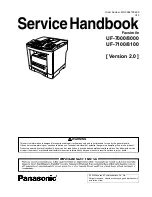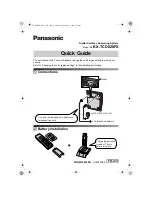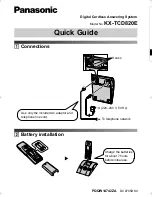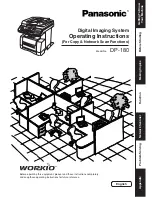
2
2
2-38
2-38
Technology > Detecting Jams > Detecting Jams (Saddle Stitcher Unit)
Technology > Detecting Jams > Detecting Jams (Saddle Stitcher Unit)
Detecting Jams (Saddle Stitcher Unit)
The saddle stitcher unit identifies any of the following conditions as a jam, and sends the jam
signal to the host machine.
In response, the host machine may stop copying operation and indicate the presence of a
jam on its control panel.
When all doors are closed after the user has removed the jam, the saddle stitcher unit checks
whether the vertical path paper sensor (PI17) has detected the presence of paper.
If the sensor has detected paper, the unit will identify the condition as being faulty jam
removal and send the jam signal to the host machine once again.
PI19
PI18
PI15
PI14
PI8
PI11
PI20
PI17
PI22
No.
Sensor
PI8
Paper positioning plate paper sensor
PI11
Delivery sensor
PI17
Vertical path paper sensor
PI18
No.1 paper sensor
PI19
No.2 paper sensor
PI20
No.3 paper sensor
PI22
Saddle inlet sensor
F-2-82
Jam Type Sensor
Jam Condition
Inlet delay PI22
When the saddle inlet sensor (PI22) does not detect paper after a prescribed
time (distance) has elapsed since receiving a saddle delivery request from
the Finisher.
Inlet
stationary
PI22
When paper does not exit the saddle inlet sensor (PI22) after feeding for
a prescribed amount with the feed motor (M1) after the saddle inlet sensor
(PI22) detected the leading edge of the paper.
Feeding
delay
PI18
When the 1st paper sensor (PI18) does not detect paper after prescribed
time (distance) has elapsed since the saddle inlet sensor (PI22) detected the
leading edge of the paper.
Feeding
stationary
PI18
PI19
PI20
When paper does not exit the 1st paper sensor (PI18), 2nd paper sensor
(PI19), and 3rd paper sensor (PI20) after feeding for a prescribed amount
with the feed motor (M1) after the 1st paper sensor (PI18) has detected the
leading edge of the paper.
Delivery
delay
PI11
When delivery sensor (PI11) cannot detect the paper after feeding the stack
for a prescribed amount with the paper folding motor (M2) after completing
paper pushing motion with the paper pushing plate.
Delivery
stationary
PI11
PI17
When stack does not exit the delivery sensor (PI11) after feeding the stack
for a prescribed amount with the paper folding motor (M2) after detecting the
leading edge of the paper with the delivery sensor (PI11).
When stack does not exit the vertical path paper sensor (PI17) after feeding
the stack for a prescribed amount with the paper folding motor (M2) after
detecting the stack with the delivery sensor (PI11).
Stitcher
staple
SW7
SW5
When stitch motors (M7/M6) are rotated forward and the stitch home position
sensors (SW7/SW5) do not turn ON within 0.4 seconds after they are turned
OFF and the motors are rotated backward and the sensors turn ON within 0.4
seconds.
Power-on PI8
PI11
PI17
PI18
PI19
PI20
PI22
When paper is detected by one of the sensor on the paper sensor PCB (1st
paper sensor (PI18), 2nd paper sensor (PI19), 3rd paper sensor (PI20)),
vertical path paper sensor (PI17), delivery sensor (PI11), paper positioning
plate paper sensor (PI8), or saddle inlet sensor (PI22) during power ON.
Door open PI3
PI9
PI102
When the delivery cover sensor (PI13) or inlet cover sensor (PI19) detects
that the cover is opened during operation.
When the front cover sensor (PI102) detects cover open with paper present
on the processing tray while the device is not operating.
T-2-11
Summary of Contents for J1
Page 4: ...Blank Page ...
Page 8: ...Safety Precautions Notes Before it Works Serving Points to Note at Cleaning ...
Page 58: ...3 3 Periodic Servicing Periodic Servicing List of Work for Scheduled Servicing ...
Page 99: ...5 5 Adjustment Adjustment Outline Basic Adjustment Adjustment at Time of Parts Replacement ...
Page 133: ...Appendix Service Tools General Circuit Diagram ...
















































